Entries Tagged as 'Aidan'

CT logo from “cinnamon.org.uk”
Though I haven’t gotten to see the results of my volunteering manifest in the community the way some others have, I feel like I’ve learned something about Norwich, but particularly Britain, from it. Looking for volunteering opportunities, a process which was late to begin with because I had held out hope of reconciling my paper with my experiential, was itself a tedious game of email tag and involved being crushed to see I inexplicably needed a background check for certain great jobs. However, I think I did notice some unusual trends in what volunteering was out there.
Firstly, although Claire came up with the idea for the first Holiday from Home from her own experience being unable to travel due to severe ME, and it is her own ingenuity and passion for travel which prompted her to develop the project into a larger organization, there is something else in the mission of HFH which speaks to something larger. This is the idea that travel is almost a right or at least something that ought to be available to everyone as a matter of fairness seems to me a quite British idea (despite Britain not having a stunning national record on accessibility for the disabled).
After all, this is a nation where small bookstores will devote a whole wall to travel books and a Google search for British Travel yields more mentions of deals for Brits to go to Mallorca, Egypt and India than for foreigners to go to Scotland or Cornwall, which led a friend of mine to conclude that “the English seem to spend all of their time plotting how to get out of their country.” The first item on the HFH mission statement is “the advancement of health,” which I find to be an innovative way to think about the concept of travel.

Age Concern Norfolk Logo- “www.acnorfolk.org.uk”
This leads me to a wider point about volunteering opportunities in the Norfolk area and nationally: I was impressed with the amount of organizations which catered to the needs of the elderly, and did so in nontraditional ways. I would count Holidays from Home among these, but other larger and more national organizations do this as well. One example is the Cinnamon Trust, which helps to “relieve the anxieties, problems and sometimes injustices, faced by elderly and terminally ill people and their pets, thereby saving a great deal of human sadness and animal suffering.” Another is Age Concern Norfolk, which Anya explored as part of her experiential. It is an organization that offers volunteering roles from keeping older people active to helping with personal finances, all with a eye on companionship.
Doing what you can to help create a holiday or spending some time with an elderly or ill person while looking after their pets address important but often overlooked emotional needs of older people and are something that anyone can do, even for a few hours a week without having to have a background check. I saw a remarkable number of these organizations, both national and local, which is good, especially because I don’t see British culture in general as being notably reverent towards older people. I have no basis for comparison in terms of whether Norwich or Norfolk is exceptional in this regard, but it would be interesting to see whether a younger, larger urban area has as many opportunities in this vein.
I’m still hoping to learn more from my Holidays from Home experience, and because I can volunteer remotely, I intend to do what I can over the summer. Perhaps I’ll be able to see the fruits of my labor in the new holidays. Even if I do not, I feel I’ve gained something from the experience.
Tags: Aidan
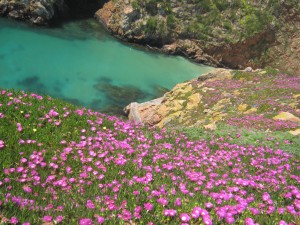
A scene from one of the many amazing vacations I've taken just this year, something I do indeed take for granted
Though I would have liked to do something related to my paper on English identity, I wasn’t confident enough that I could get deeper into the issue through interviews of participant observation, especially with a topic so latent and personal. Instead, I chose to look for volunteering opportunities around Norwich, hoping I could learn more about the community and ideally have it relate to my topic. Though I’m happy to have helped out (and want to continue to do so) at Holidays from Home my (fairly long) search for a more relevant volunteering opportunity has actually shown me valuable things about the nature of charity and volunteering in the Norwich area and in Britain as a whole, which I’ll be addressing in subsequent posts.
Holidays from Home, as Sarah, who’s also volunteering for this group explained in her blog is a Norwich-based organization which provides “virtual holidays” to people who are ill, disabled, elderly and homebound. These holidays are multifaceted; they use books, sounds, the internet, films, and other media to give the traveler a comprehensive, intimate, life-like experience. Though just a few full holidays have been created in its four year existence, HFH just received a lottery-funded grant to offer 400 holidays to people in Norfolk. Volunteers were needed to develop new holidays and tweak the old ones to be a bit more user-friendly.
Though I volunteered to do research and give notes of my travel experiences (that’s what Sarah’s doing) founder Claire Wade wanted me to spend time looking into how to incorporate Google Earth technologies (cheers, KQ) into the existing holidays (with which I’ve had mixed results). The idea is to provide a quick one link that could either lead directly to a tour or to a Youtube video so as to simulate views or travel in a more lifelike way than before. Any input from any Google Earth specialists or anyone who managed this for 310 would be much appreciated. More on HFH upcoming along with my thoughts on some similar organizations I came across in my search for volunteering. Also, I hope to throw in a few posts on some interesting parts of my English Identity research I didn’t get to address in more than a few sentences in my paper.
Tags: Aidan
February 14th, 2010 · 1 Comment

historic-uk.com

bbc.co.uk
For my paper assessing the perceived recent revival of specifically English identity, my experiential component will hopefully be a patchwork of interviews, participant observation, and attending of events related to political organizations and causes connected to English identity, such as the Campaign for an English Parliament. Last Saturday, I decided to start my experiential off in sort of the shallow end with some participant observation of an England v. Wales Six Nations Rugby Match at the Murderers Pub in the City Centre.
While my paper is likely to focus more on the political and social implications of a rise in English Identity, cultural institutions and particularly sports teams are some of the most visible institutions which divide the UK. Rugby, like football and cricket, is one of the sports in which England, Scotland, Wales and Northern Ireland compete separately in international competitions, and I’d hoped watching the behaviour of English Rugby supporters (especially interaction with Welsh supporters and the ways in which they showed support for their team) would give some indication of where investment in national sports teams fits into this rise in English identity.
The crowd in the Murderers Pub was substantial on this Saturday afternoon, large especially given the fact that the rugby was live on BBC One, so it was hard for me to find a perch from which I could best observe things. The majority of the crowd were white men between about thirty and sixty, about ten of whom were wearing England rugby apparel and watching on the large projector screen. The rest of the patrons, however, seemed just as likely casual fans of rugby than England die hards. I was glad to see that there were a decent number of Wales supporters as well, and they made a decent roar when the Welsh scored. These ex-pats seemed much more likely, percentage-wise, to be wearing Wales apparel than their English counterparts did English apparel, and one older woman was even wearing a Welsh flag sort as a sort of cape. One interesting thing about England v. Wales is that essentially the English are taking their opponents on at their “national” sport. Although I could not record every interaction between the English and Welsh supporters, things generally seemed very cordial, without too much interaction at all between supporters.
Also, I was looking to see what symbols are associated with support of the English national team, and was a bit surprised. I saw very little of the Cross of St. George (which is likely to be a focus of the paper, and actually flies above the door at the Murderers). While the St. George flag has become identified more and more with England Football, the rugby team uses another symbol of Englishness, a red rose, on their jerseys. This underlined my most significant observation of the day: support of this national team does not seem to be conflated with any sort of political nationalism in the least, at least for Rugby supporters. For example, when England made the decisive score towards the end, the core group of England supporters did not belt out God Save the Queen, as England football fans sometimes do at such a moment (even, presumably, when playing another British team). Rather, they sang the American spiritual Swing Low, Sweet Chariot, which became associated with the English national team about twenty years ago. This may have to do with the English rugby still feeling like almost a niche sport and community compared especially to football in England, and so rugby fans have developed their own unique rituals to distinguish themselves. After all, when the English football team wins a big match, it generally is a moment of unusual English national unity deserving of God Save the Queen, whereas interest in English rugby still doesn’t seem to cut across the whole of society in that way.

irishrugby.co.uk
I hope to apply these very preliminary findings to my research and experiences in the coming months on the cultural side of English identity. Oh, and England won by a final score of 30-17, and I pretty much have the rules of the sport down now. Give rugby a shot if you haven’t yet, it’s actually very watchable. And I can’t recommend the Murderers highly enough either.
Tags: Aidan
September 14th, 2009 · 1 Comment
In hindsight, loading our month in London with plays was a very good idea. I wasn’t so sure when we began that it would be. Especially given the diversity of the theatre experiences we had: The Globe, a heady comedy-drama in the West End, Shakespeare at The Olivier Theatre, Back to the NT for a contemporary English class drama, then finishing up with a musical that’s been running forever in the West End. That hardly sums up the entirety of London theatre, but these experiences gave us a small sense of the myriad theatre traditions and experiences the city has to offer. Maybe as importantly, they served as a break from tours, walks and other activities which involved actively learning about the history and economics of London and instead allowed us to enjoy one of London’s truly greatest products firsthand.
“Hector is Dead!”
I was perhaps most surprised by enjoying Troilus and Cressida at the Globe. I was not heartened when, in the minutes before the show started, the guy behind me showed up with Starbucks cup in hand (A.N. Wilson had specifically lamented the fact that there was a Starbucks within shouting distance of the recreated Globe). With what I knew about the original Globe and after reading Wilson’s dreadful review, I was all ready to agree that a Disney-ish Globe recreation where groundlings stand but there’s no audience interaction or adjacent bear beating just wasn’t The Globe. But a few minutes in I decided I should just stand back and enjoy it. The cast and crew should be commended for making a consistently compelling production of a difficult Shakespeare history, even if it occasionally was a bit Disney-ish. I don’t think any of us who read the play were expecting such a good experience.
“Bring a Book”
Head craning and head scratching though it may have involved, Arcadia was my favorite play and the Duke of York Theatre my favorite theatre. I thought the Duke of York was a cool space; intimate enough for an intricate and intense play like Arcadia but not too small to provide the uproarious laughter the play deserves. I actually liked where we sat, which I thought provided a better view of the whole play’s upstage and downstage action. I’m sure I didn’t even come close to understanding Arcadia, but with any difficult work of art all I ask the first time around is if I’m left intrigued enough to want to see it again, and I absolutely feel that way about Arcadia.
“My Mind is Wrapped in Dismal Thinkings”
I feel mostly positively about All’s Well That End’s Well at the Olivier, and I think that puts me in the minority. It’s certainly a frustrating play in terms of a sort of flimsy premise and (personally) unsatisfying ending (sometimes it seemed more Gilbert and Sullivan than Shakespeare), but I thought the unique set design, lighting, and music deserves credit for making the play much more endearing than I imagine it would be on the page. The Olivier must be the largest space I’ve ever seen a play in, and this particular production did suit the enormous space. I’m not sure if I’d go back to see another play there unless I was sure that particular production could accomplish this. That said, I feel very positively towards the National Theatre, both in terms of the building and its mission, both of which I addressed a few weeks back.
“No One Ever Gave Them a Paintbrush!”
I wish I’d gone back to the Globe for As You Like It, which I heard glowing reviews of from everyone, but I felt a little tired and Shakespeared out. The Pitmen Painters at the Lyttleton Theatre more than made up for it, though. Almost everyone has put in their two cents on the philosophical or political meaning of the play, and there certainly is a lot to ponder and debate there, but the main theme that stuck with me is the debate over what art is supposed to mean and what relationship the individual is supposed to have with it. Of course the play frames this as a political question, but I think it’s a fundamentally human one that works of art themselves don’t always address well. I had a few problems with the play as well, particularly the last scene (which was like being hit with a socialism-lamenting dead fish after several hours of relative subtlety). I thought it was worth seeing for 27 foreigners trying to understand England as it obviously focuses on class distinction, but also language and accents and geography. We often (given our maybe skewed perspective) don’t think of where one lives in England as having as much of an effect on identity as where one lives in America. However, I think Ashington is a good example of a place that’s so socially and economically isolated from the rest of the country, even if it’s not as geographically far away as, say, West Virginia is from New York City. All the more reason The Pitmen Painters was a good thing to see before heading off to Norwich.
“(ominous keyboard chord)”
I won’t pile on Blood Brothers at the Phoenix, and instead I’ll say that it certainly represents a mainstay of the London theatre scene. Namely the for-profit, familiar show of middling quality which thrives (but doesn’t necessarily dominate) the West End. Rick Fisher talked about this kind of show, and how it’s come to mean that some of the best, most innovative and fun stuff now is at the pub theatres and black boxes all around town. A thing to think about next year might be going to the National Theatre’s black box (presuming the play there is worth it) or venturing even further into the fringe of London theatre. However next year is scheduled, I hope the students somehow get as much quantity and quality in their theatergoing experiences as we did.
Tags: Aidan
September 12th, 2009 · 4 Comments
Shame on you, Mr. Orwell, for stealing my pub blog post opening gambit: talk about all of the little aspects of my idea of a perfect London pub only to reveal that regrettably (spoiler alert) no such pub exists. That was totally my plan halfway through your essay! Sure, you wrote yours 63 years earlier but, come on, mine is actually for a grade.
With only three and a half weeks of London under my belt I wouldn’t profess to know as much as George Orwell about London pubs, but I had intuitively been coming to the same conclusion before I read The Moon Under Water. No pub (speaking for myself) comes even close to appealing all the time. If I want to have a quick pint or two and a plate of chips with a few friends on a weeknight, I’ll go to the Marlborough Arms. If it’s a weekend night and there’s nine of us and I want to be packed like a sardine and converse in my loudest American voice to cacophonous strains of either Aha’s Take On Me or Franz Ferdinand’s This Fire, I’ll head up to The Court. If I’m feeling adventurous and looking for something new, I’ll head farther afield. I’m surprised Orwell found a single pub that even satisfied eight of his ten criteria, actually, although it was a different era and he’d been to a lot more pubs than I have.
I don’t think I’m really getting that much of a sense of British culture through going to pubs yet, but it certainly does seem to be one of the only public spaces we’ve seen that does seem to have any degree of sociability. The English don’t seem to usually be gregarious with people they don’t know ever ( be it on the tube, in the park or at a pub), but it is the only place we’ve seen the English really commune with friends and share stories, celebrations, anxieties etc. This obviously is the same with American bars, but the ubiquity of pubs (although they’re getting less ubiquitous) and the fact that it’s socially acceptable for everyone to go seems to make them more of a fixture in British life. I’ve sensed some disappointment that so many pubs actually seem to have a mostly age 30-50 clientele, but I think that’s proof that pubs are a centre of everyone’s social life , much in the way that bars were in the US until about the 1970s.
I have a feeling going to pubs in Norwich will give me a lot more insight into pub culture in England than being in London has. I would imagine pubs will be even more central to social life in a city without the myriad other diversions London has, and the lack of tourists and recent city transplants will perhaps make for a more typical English pub scene with more regulars and lower prices. I know I’ll be comparing and contrasting the experience of going to pubs with other students and the experience of venturing into pubs in the city (and comparing and contrasting the places we go as well) once we’re there.
Oh, and Mr. Orwell, let me tell you about my favorite London pub. It’s a little off the beaten path but still close by. It’s called the Moons Over My Hammy, after the borderline inedible Denny’s breakfast entrée and thus is full of ironic Americana décor. However, everyone there (but me) is English, and unusually gregarious. There is plenty of seating indoors but a good atmosphere out on the pavement, too. There’s a different football match on every TV screen, and you don’t need to buy a drink to watch. The music is always great and (this is most important) every hour starting at 10 (on the hour) Darude’s techno-pop hit “Sandstorm” is played, and everyone dances intensely for its duration. Oh yeah, “Sandstorm.” I understand this is fanciful and unrealistic, but so is the idea that there ought to be a pub somewhere just for you.
Tags: Aidan
September 10th, 2009 · 1 Comment
I already addressed the differences in national appreciation of art between the UK and US in my post last week about the theatre, but recently I’ve been thinking about it again. Although I didn’t get to catch all of what Sir Peter Maxwell Davies said in his preconcert interview Tuesday, I was struck by a topic he and the interviewer both seemed anxious to discuss: music education. More specifically, that it is not requisite and rather is sometimes absent from the UK curriculum. For those of you who didn’t go to the talk, Sir Peter holds the title of Master of the Queen’s Music, conducted the first two pieces last night, and was the composer of the violin concerto which had its premiere last night. He made the important point that British schools do a disservice to the youth of the country when they underestimate their ability to be intellectually challenged, particularly by the seemingly more abstract fields of art and music. He said that youth want to be challenged and, cynical though I am about a lot, I absolutely agree. I feel, as I imagine Davies would, that there needs to be some mechanism (through schooling or some other way) for forcing (for lack of a better word) art, music, science and discussion and debate of relevant issues on the public. This kind of thing may be scarce in Britain, but it seems absolutely extinct in America.
After all, on Tuesday night we saw a great Proms concert that (if it wasn’t live last night) will be rebroadcast on one of the lower number BBC Channels in the next few days. That would be like me going to a challenging but enjoyable Baltimore Symphony Orchestra concert and it being broadcast for the entire country on NBC the next night. I wouldn’t expect every Brit flipping through the channels to stop and be transfixed by contemporary classical music, but at least a conscious effort is being made to offer quality programming and I’m sure that has some effect (look at the crowd a Tuesday night concert with mostly unfamiliar pieces drew). I’m sure there’s much worse programming that would have appealed to a much greater audience that the BBC can show rather than the Proms, but the BBC is lucky enough to not be funded by advertisers and so it doesn’t have to cater to the lowest common denominator the way networks in the US often have to. Davies may be right that the British public in general and youth in particular are not being challenged, but at least the Proms broadcast is a small sign that those with the power to control programming in Britain have some inclination towards placing art and music front and centre.
My father told me that when he was in elementary school, once in a while everyone would be shepherded down to the auditorium to watch film of Leonard Bernstein’s Young People’s Concerts together. I imagine there were people in his class that had no interest in classical music then or today, but I imagine the films struck an interest in music in at least a few. If there were efforts to expose me to art and music when I was young it was always cursory (more cursory even than watching film of full concerts), underfunded or both. I support Sir Peter’s cause of really making an effort to expose kids to a wider range of great art and music at a young age, and think that the Proms is a good example of how an effort on an even larger scale can really pay off.
I briefly wanted to mention that I really enjoyed Tuesday night’s concert. I thought it was actually the perfect program for us in that it included a fine romantic overture, a challenging piece of contemporary British music (in its UK premiere) and an also interesting Sibelius symphony, with a finale that’s hard not to love (and which, strangely enough, was mentioned in one of the London poems we all read). While I’m still not sure I understand everything about the structure of the Proms, it does seem like a very unusual and impressive event, and I’m glad to say I had the chance to go. I’m starting to conclude that for all the amazing opportunities we’ve had in London, down the road I’ll most appreciate the chance to see so many great performances (both theatrical and musical) for free (well, free for me, anyway).
Tags: Aidan
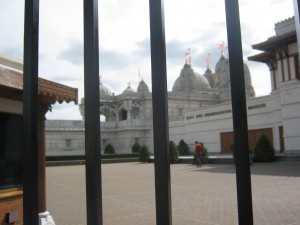
I’ll start by discussing our trip to the Shri Swaminarayan Mandir on Sunday, which I think was on balance a positive experience, despite my serious reservations about the implications of some aspects of their tour. I liked best having a chance to learn about all the functions and spaces of a Hindu temple and also getting a sense of Hindu prayer, which I’m ashamed to say I’ve never really looked into. On the other hand, I really disliked some aspects of the tour, particularly the Hinduism exhibit and what I’ll call the “wall of famous white people who approve of us.”
Some of the former was presentation of simple facts about Hinduism as a whole, but not nearly enough of it was. The rest of it sought to elevate their particular sect above the rest, elevate Indian civilization above western civilization, and at the same time imply that quotes from white historians and writers about Hinduism should be what convince the British masses to accept Hinduism. I can understand being proud of one’s particular sect, but the last two do a disservice to the exhibit. I approve of recognizing the formidable achievements of Indians throughout history as part of a Hinduism exhibit, but I cannot support essentially saying that every innovation in history is proof of the superiority of Indian civilization (the most silly panel was something like this: Indians invented the concept of zero, think how many times those crazy Romans would have to write M to get to 10 million before we set them straight!)
The quotes from white historians and “wall of famous white people who approve of us” are altogether more problematic. The fact that they were a centerpiece of the tour makes me feel as though the Mandir has more of an interest in making Hinduism superficially palatable to the UK population rather than really providing a place where the curious and faithful alike can get a better and deeper sense of the true meanings of Hinduism. Although I may not like it, the wall is proof that this particular mandir does a good job (of superficially) getting its name out there and interacting with the community around it and indeed the nation’s leaders. While I understand that not every Hindu temple has the resources or inclination to do this, the fact that such a large one manages to do this can be seen as proof that Hinduism is on track to do better rather than worse in acculturation. If there’s anything working against Hindus on that front, it’s likely current population. Hindus were only 1% of the UK population in 2001 (which really surprises me) and this might be detrimental to the population’s visibility within the country.
Sikhs appear to face a few unique challenges to acculturating. The first of which is dress, which is more distinctively strict (at least among devoted Sikhs) than in Hinduism or Islam. While I think it is certainly possible to acculturate with strict religious dress, some groups in history (Jewish immigrants on the Lower East Side, for instance) have relaxed religious dress as sort of the first step to full scale integration into their new nation. If this would also be true for Sikhs, it will have the negative side effect of forcing individual Sikhs to choose devotion to religion or the possible benefits of acculturation, and perhaps put a greater gulf between the older and younger generation of Sikhs (which if we are to believe our tour guide Mr. Singh, is already there). I’d like to do a bit of research into the Sikh population as a whole in Britain, perhaps to see if there’s a guardwara in London that serves a similar kind of function as the Mandir does (in terms of outreach). If so, that would likely be beneficial for them in terms of becoming part of getting Sikhism in the national consciousness. The Southall guardwara seemed less used to public relations and (while in a diverse community) seems a bit cut off from the whole of London.
Although we haven’t discussed them in a bit and didn’t get the chance to go to a mosque, I felt the need to mention Muslims in Britain and where they may fit into all of this. Muslims, too, have a unique problem as evidenced by the cover of last night’s evening papers. British Muslims, though they make up the largest share of the population among these three religions, seem to mostly get in the papers in relation to extremism or terrorism. Over the weekend, there were violent protests of Islamic fundamentalism in Birmingham which led to ninety arrests (it’s unknown if the protesters or counter-protesters started the violence, but unfortunately it looks as though it all might happen again). Our reading from about a week and a half ago about police and national relations with the Muslim community mentions that one of the scariest things to many Britons about 7/7 was that one of the planners spoke in his tape with a broad Yorkshire accent, making British Muslims to some seem like the frighteningly hidden enemy within.
That same article outlined ways to improve relations between Muslims and national institutions like the police and the press through mutual respect and cooperation. Hopefully this will come about. Working for Muslims, although I’m not sure of the more recent immigration trends, is that they make up a slightly larger percentage of the population, closer to three percent than the one percent of Hindus and Sikhs. Muslims have already made large parts of the bigger English cities (London and Birmingham, for example) their own, so they likely don’t have the exposure problem Sikhs and Hindus might. Now it’s just a matter of getting better exposure. Predicting acculturation into a new national identity is always tricky, and without foreknowledge of events and immigration trends I won’t bet on any of these three groups to be there first. Each seems to have unique advantages and challenges, and how each community will manage them doesn’t yet seem clear to me.
Tags: Aidan
I try not to be biased against a museum’s collection because of its particular layout, especially one as restricted as Sir John Soane’s, but I feel that Mr. Soane’s museum was just too prohibitively small to have the kind of impression that he himself wanted it to. The stated purpose of John Soane (an architect by trade) turning his home into a museum was to “preserve [his] house and collection for the benefit of ‘amateurs and students’ in architecture, painting and sculpture.” Rather than gain any further concrete knowledge of these subjects at the Soane, I felt cluttered by what just instinctively felt like cartoonish opulence.
The signage was so sparse that I learned about one in ten of the individual objects rather than collections as a whole and how they relate to Soane or his areas of expertise. I doubt an audio tour would have even been able to cover much of the collection, either. I did get a sense of the importance of Mr. Soane’s work itself, but even this part of the museum consisted of many of his drawings gave me no sense of the arc of his career or his greater role in architecture. As I addressed in my V&A post, an eclectic collection is not enough to doom a museum to failure, but the Soane just fails to create any concrete impression on its guest besides the feeling of being overwhelmed by amazing and historic things.
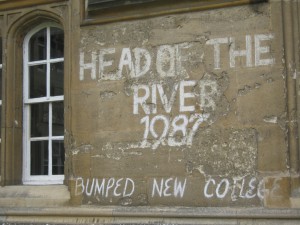
Rowing graffiti at Corpus Christi College
Oxford is overwhelming in a much better way, if that makes any sense. I won’t speak for the group that did not have a good guide, but I think I got as good a sense of the past and present at Oxford (which are pretty much the same) as one can get when students and faculty are not there. I was glad at first to not be going to Oxford when classes were in session (so as not to be a gawking tourist), but now I wish I’d been able to see Oxfordians (Oxforders? There’s probably a much cooler name than those that us outsiders aren’t supposed to know) interact with the place. Don’t get me wrong, I was delighted to admire the buildings on their own (particularly the dining halls, which are even more stunning than in movies like Chariots of Fire [actually I think that’s at Cambridge]), but going when the University was entirely empty almost made it seem like a museum made from an abandoned University rather than one of the current greatest academic institutions in the world.
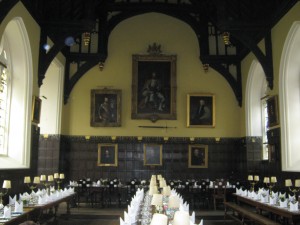
The Dining Hall at Oriel College
All of this will help me decide when to go to Cambridge, as will my desire to stay away from tourists there for the shopping. Although I walked around and saw plenty of the University before the tour, I didn’t really believe I was in Oxford until I entered that quad at Lincoln College and felt shut off from the street performers, KFCs and the like. I wonder how the sheer volume of tourists affects students’ ability to have a truly authentic Oxford experience like their predecessors (Brandon asked something like this, but I think our guide was confused). Similarly, I wonder if the cache of living in Oxford has driven housing prices so high that many of those who work at the University must live farther away. All things to explore when I make another pilgrimage one day.
Tags: Aidan
September 4th, 2009 · 1 Comment

For a week and a half I’ve been telling people that St. Paul’s is my favorite building in London, even though I’d yet to go inside. I think it’s something about how it fits snugly in the city skyline, and yet at the same time seems totally foreign and unique. I prefer it to Big Ben as the quintessential symbol of downtown London and prefer it to Westminster Abbey as a church. Even if those photos of the dome standing tall during the blitz were doctored for propaganda purposes, they move me because even today I can get a sense of how inspiring they must have been to Londoners and indeed all Brits.
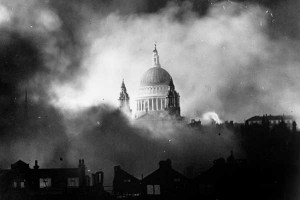
BBC image of St. Paul's in the blitz
That said, I was indeed impressed by the inside when I had a chance to see it. Although it’s certainly ornate, it seemed simpler and less cluttered than Westminster Abbey. The inherent awkwardness of St. Paul’s is that it has become the church most associated with elaborate monuments and graves to military men, and therefore is seen as glorifying war. I thought it was interesting that the hourly intercom prayer focused mostly on making the world a more peaceful place, seemingly to counteract the church’s obvious image. Anyone else notice that?
In retrospect I’d rather have climbed up to the dome (next time I will) but instead I chose to go down to the crypt to hear a little more from John. I really admire John’s ability to do what he does as well as he does it. The best I can describe what he does so well is point out the interesting minutiae while at the same time linking that back to an overall narrative which gives one an impression of what the particular place really means as a whole. Most tours, both audio and human, just don’t achieve this.
Staying for choral evensong was a good choice, although we should have sat up with the congregation rather than back with the tourists to really hear the choir sing. Nonetheless, the service was something to behold both visually and sonically. An organ and a great small choir in an amazing space is just about as good a musical experience as can be had, I think. The one problem I had with the experience was tourists just milling about the sides of the church during the service. During mass at Santa Maria Maggiore in Rome I saw this, too, and couldn’t believe people felt comfortable doing it. I understand why St. Paul’s (and the Abbey, for that matter) are and should be viewed as a museum to British history and religion, but I feel there should be times when it is a museum only and times when it is a place of worship only.
Not for reason of comparison, but just for the sake of convenience, I’d also like to add my thoughts on the guardwara (which we were lucky enough to not have to treat like a museum). I was glad to have a guide who was eager to talk to us about his faith but was not a rehearsed guide. This gave us a chance for a more candid exchange and probably a much more authentic experience. I noticed how, twice, other Sikhs just came up to hear what he had to say to us about Sikhism (and they just seemed interested, not wanting to correct him or know who we were).
One thing I should have mentioned this morning, during our brief discussion of St. Paul’s and the guardwara and Christianity and Sikhism, was that Sikhism is a religion that has a history of religious violence (despite its very pacifistic core). Some of you may have noticed a sign yesterday asking Sikhs to remember those who died in Operation Blue Star on its 25th anniversary. This was an operation ordered by Indian PM Indira Gandhi against Punjabi Sikh separatists who were amassing weapons in a temple. In the wake of Blue Star, Indira Gandhi was assassinated by her Sikh bodyguards. Sikhs, like members of other religions, struggle with when to take up the sword in defense of what they believe to be justice and honor and when to turn the other cheek, so to speak.
Tags: Aidan
September 2nd, 2009 · 1 Comment
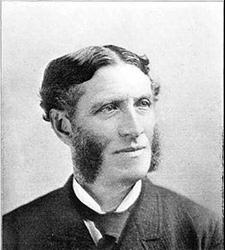
Mr. Arnold: enthusiastic about theatre AND a pair of mutton chops to die for
So said poet Matthew Arnold, more than eighty years before a National Theatre largely subsidized by the government, to which he referred, would actually come about. Last night I saw a good, fairly ambitious staging of All’s Well That Ends Well at the National Theatre for 10 Pounds. I, too, am wondering why this institution which serves as both promoter of theatre to the wider public and patron of the fringe and experimental, wasn’t part of British life sooner.
The last few days have truly been remarkable. I’ve gotten to see great, well acted productions of Stoppard and Shakespeare for free (for me at least). I’m fairly sure there’s nowhere else in the world that this could be done (without a great deal of generosity). After last night and tonight, I’m particularly regretful that I won’t be able to see many more great plays (because of time constraints) even though I’m spending a whole month in London and I might be reimbursed for it.
Anyway, I really did enjoy Arcadia, even if I’ll need to read it, see it again, and then read it again to even get a whiff of what Stoppard ultimately meant. I had the same feeling on reading Rosencrantz and Guildenstern are Dead only one time through (oh, and Travesties was the other play I was thinking of the other day).
All’s Well That Ends Well, despite being a sometimes infuriating play in terms of theme and (ironically) the ending, was also a valuable experience. Mr. Fisher would be happy to hear that I made a conscious effort to consider the lighting as part of the storytelling for probably the first time ever. In retrospect, the lighting went a long way towards creating a feel of a dark, imperfect fairy tale that I think this production was going for. The set design, which frankly is what really got me interested in coming back to see the play, was even better than I imagined.
Although one might expect a national theatre to put on spectacular stagings of Shakespeare in spaces that fit upwards of a thousand, the thing that struck me on our tour yesterday was that the National Theatre also devotes resources to creating and staging experimental work even if it will not appeal to the general public or bring back much money. Creating three spaces to fit the needs of very different plays when the Theatre was created is evidence that the Theatre is devoted to both offering inexpensive access to great productions and helping to foster a wide range of plays and playwrights.
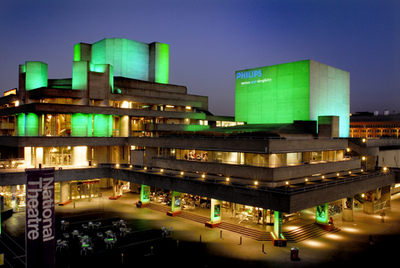
Stunning Photo of the NT at night
I wonder if Brits are aware of how spoiled they are compared to Americans in terms of having fine art subsidized and made somewhat affordable for them (maybe this is why they wear jeans to plays). Judging from the crowd at All’s Well (a near sellout on a Tuesday night three months into the production), they are appreciative of the National Theatre and want to support it. I can’t help thinking this is a great example of how a governmental investment in the fine arts can truly pay off, and how the United States should consider a greater investment in such artistic institutions which are beneficial to society in more ways than one.
While I don’t know if an institution exactly like the National would be feasible in America, I do know that seeing multiple great, professionally produced plays in the US often means going only to New York and spending hundreds and hundreds of dollars. While people spend that much in London, too, Mr. Fisher mentioned that the more innovative and ultimately worthwhile theatre is generally done by the cheaper, subsidized theatres. Also, although this might be hard to sell to constituents who understandably have government money in mind for other purposes, it’s just in a country’s interest to support the creation of great art. It’s great to see that this seems to be understood in Britain.
Tags: Aidan












